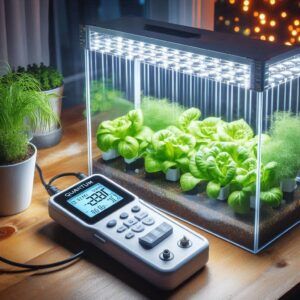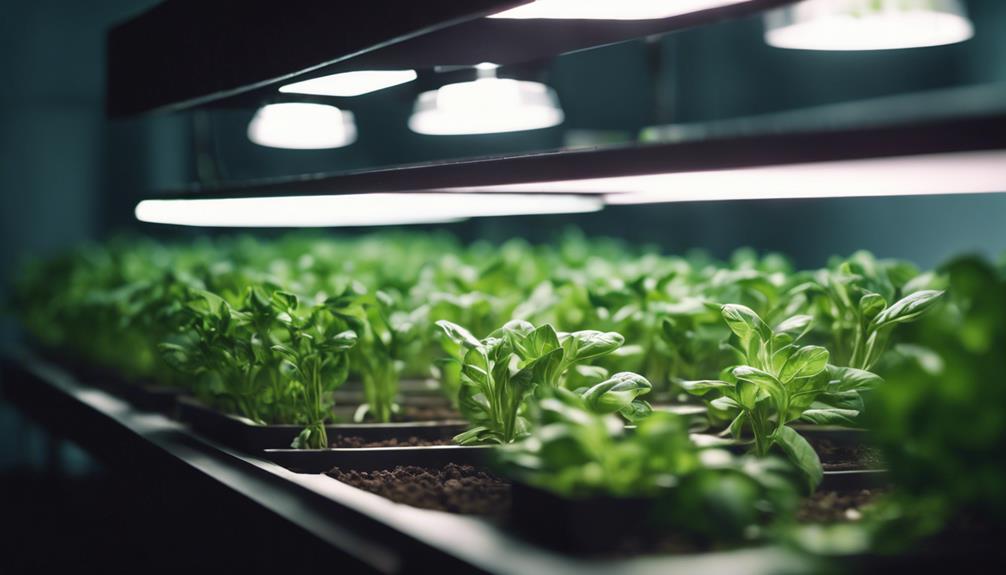How Can We Improve Grow Light Effectiveness with a Quantum Light Meter?
Quantum light meters are essential for gauging grow light effectiveness by measuring photosynthetically active radiation (PAR) within the 400-700nm range. They help improve lighting conditions for ideal plant growth, ensuring plants get the right amount of light for photosynthesis. You can determine grow light effectiveness with a quantum light meter. Then you can precisely adjust grow light placement and intensity to prevent light burn or deficiencies. Achieving best light levels, specific to each growth stage, maximizes plant production and yield. The benefits extend to enhancing plant health and efficiency. Understanding quantum light meter usage is vital for successful plant cultivation.

GrowHydroHerbs TLDR
- Quantum light meters measure PAR for optimal plant growth.
- Assess light intensity in photosynthetic photon flux (PPF).
- Determine ideal light placement and intensity for plants.
- Ensure correct light levels for different growth stages.
- Improve efficiency, yield, and plant health with precise data.
Importance of Quantum Light Meters
Using a quantum light meter is necessary for accurately gauging the effectiveness of grow lights in indoor plant cultivation. These meters specifically measure photosynthetically active radiation (PAR) in micromoles per square meter per second (µmol/m²/s), providing essential insights into light intensity for optimal plant growth.
By evaluating the light within the 400-700nm range, quantum light meters offer precise data that guides growers in adjusting lighting conditions to enhance crop yields and overall plant health. The ability to measure PPFD allows for a detailed understanding of how much light plants are receiving at specific points, enabling growers to make informed decisions about light placement and intensity adjustments.
Ultimately, quantum light meters play a significant role in ensuring that plants receive the right amount of light for photosynthesis, thereby maximizing their growth potential and overall well-being.
Understanding Light Intensity Measurements
Understanding the significance of light intensity measurements is essential for optimizing plant growth and development. By using a quantum light meter, growers can accurately assess the amount of light their plants are receiving, measured in photosynthetic photon flux (PPF) or micromoles per square meter per second (µmol/m²/s). This data is critical for making informed decisions about adjusting the placement and intensity of grow lights to meet the specific light requirements of different plant species.
Quantum sensors within the meter detect the number of photons hitting the sensor per unit time, providing a precise measure of light intensity. Evaluating light intensity allows growers to guarantee that plants are receiving adequate light for photosynthesis, which is crucial for healthy growth and productivity. The table below summarizes key points related to understanding light intensity measurements:
| Light Intensity Measurements | Benefits |
|---|---|
| Informs growers of actual light levels reaching plants | Optimizes plant growth |
| Essential for making informed lighting decisions | Enhances plant development |
| Evaluates light distribution uniformity | Maximizes plant productivity |
| Necessary for plant health and growth | Supports optimal development |
Optimizing Grow Light Effectiveness with a Quantum Light Meter
Properly positioning grow lights is crucial for maximizing plant growth and health. When it comes to light placement, using a quantum light meter can be a game-changer. These meters help determine the best distance between your plants and grow lights to guarantee efficient photosynthetically active radiation (PAR) delivery.
Placing your grow lights too close can result in light burn, while keeping them too far may lead to light deficiency, affecting plant growth. Quantum light meters provide accurate data on light intensity, guiding you in adjusting the placement of your lights for optimal plant development.
Achieving Ideal Light Levels for Growth
To achieve ideal plant growth, maintaining the correct light levels is pivotal. Utilizing a quantum light meter, also known as a quantum par meter, is essential for measuring the photosynthetically active radiation (PAR) that plants receive from grow lights. Different growth stages require specific light intensities, with seedlings thriving at 200-400 PPFD, vegetative plants benefiting from 400-600 PPFD, and flowering plants requiring 600-900 PPFD.
Beyond 1,000 PPFD, plants can face carbon limitations, but supplementation with CO2 can enhance growth under higher light levels. Proper light intensity not only maximizes plant production but also minimizes electricity usage and optimizes yields, particularly for valuable crops like Cannabis.
Benefits of Using a Quantum Light Meter

Measuring Grow Light Effectiveness with a Quantum light meters offer growers a precise and cost-effective method for enhancing plant growth. It does this by accurately measuring PAR in micromoles per square meter per second. These devices play an essential role in ensuring that your plants receive the best amount of light for photosynthesis, ultimately leading to healthier and more robust growth. By utilizing a quantum light meter, you can make informed decisions about adjusting the placement and intensity of your grow lights to meet the specific light requirements of your plants at different growth stages.
Here is a table highlighting the benefits of using a quantum light meter for enhancing plant growth:
| Benefits of Using a Quantum Light Meter | |
|---|---|
| Accurate light measurement | Improved plant growth |
| Cost-effective solution | Best light placement and intensity |
| Monitoring and maintaining best conditions | Increased efficiency and yield |
What did we learn about Improving Grow Light Effectiveness with a Quantum Light Meter?
To truly maximize the growth of your indoor plants, utilizing a quantum light meter is essential. By measuring light intensity in µmol/m²/s, this tool provides invaluable data to guarantee your plants are receiving ideal light levels for photosynthesis.
With precise information from a quantum light meter, you can easily adjust your grow lights to ensure the health and growth of your plants.
Take control of your indoor plant cultivation with the power of accurate light measurement.


